Image above: East Light and former light-keeper’s house, with ruins of the warehouse nearby, served as a base for research staff in the early 1970s. The house provided relatively comfortable living quarters for fieldwork. It eventually disappeared under a moving dune (Photo Jean Boulva, June 14, 1970).
After moving, in 1966, from McGill University in Montreal to Dalhousie University in Halifax, Ian McLaren, who over the years became a close friend, developed a research interest in the natural history of Sable Island. In 1967 he began by focussing on the Ipswich Sparrow, a subspecies of the Savannah Sparrow, which nests only on the island. In 2009 Ian recalled his early years in a post on this website.
Ian rapidly attracted graduate students as well as university colleagues to study other aspects of Sable’s fauna and flora, and the island soon became a haven for scientists interested in investigating its natural history.
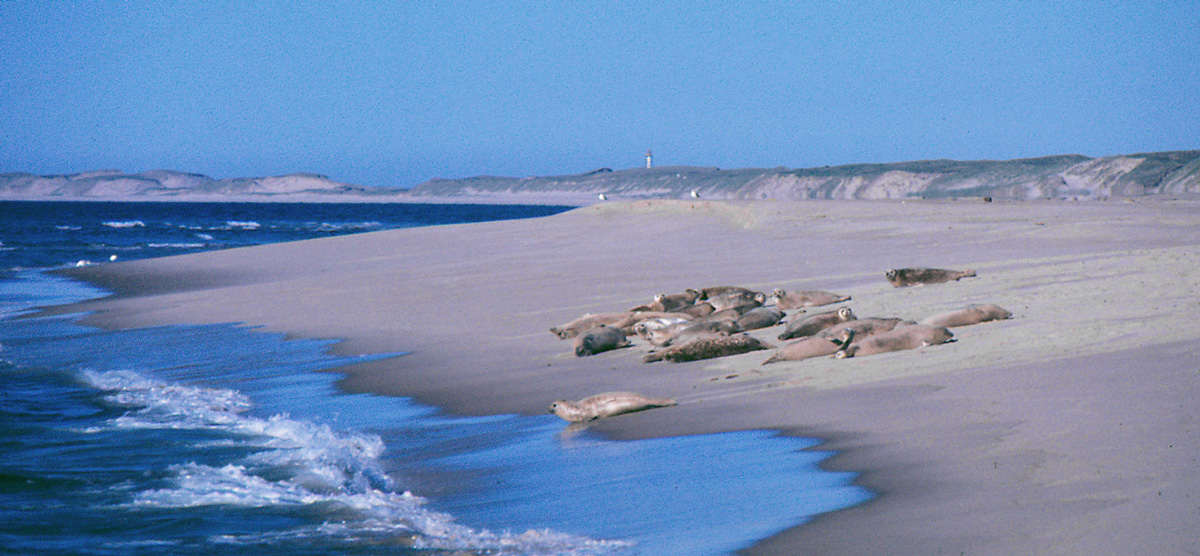
Harbour Seals on the north shore of Sable Island (Photo Jean Boulva, June 1973).
I first accompanied Ian to Sable Island in May 1968. We travelled on a small, twin engine aircraft flying from Halifax and landing on the beach. In 1970, under Ian’s guidance, I started a Ph.D. research project on the status of the Harbour Seal in Atlantic Canada. I soon found myself staying on the island for varying lengths of time during all four seasons to gather more detailed data on the small population of this species inhabiting this 40 km long sand bar far off the east coast of Nova Scotia.
Harbour Seals as well as Grey Seals were monitored by personnel with the Fisheries Research Board (FRB) who also visited the island seasonally and resided at the former light-keeper’s dwelling at East Light. They used a farm tractor for transportation, and I ended up also using it during my study on the island. The FRB also gave me access to its collection of seal specimens and provided logistic support for the fieldwork.
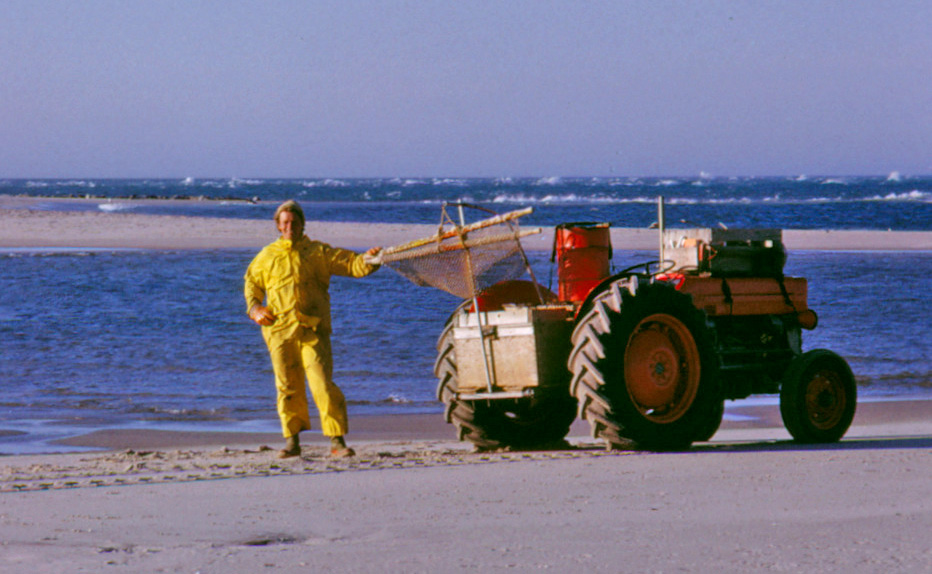
The author with his tractor equipped with a net to weigh seal pups (Photo Simone Fugulin).
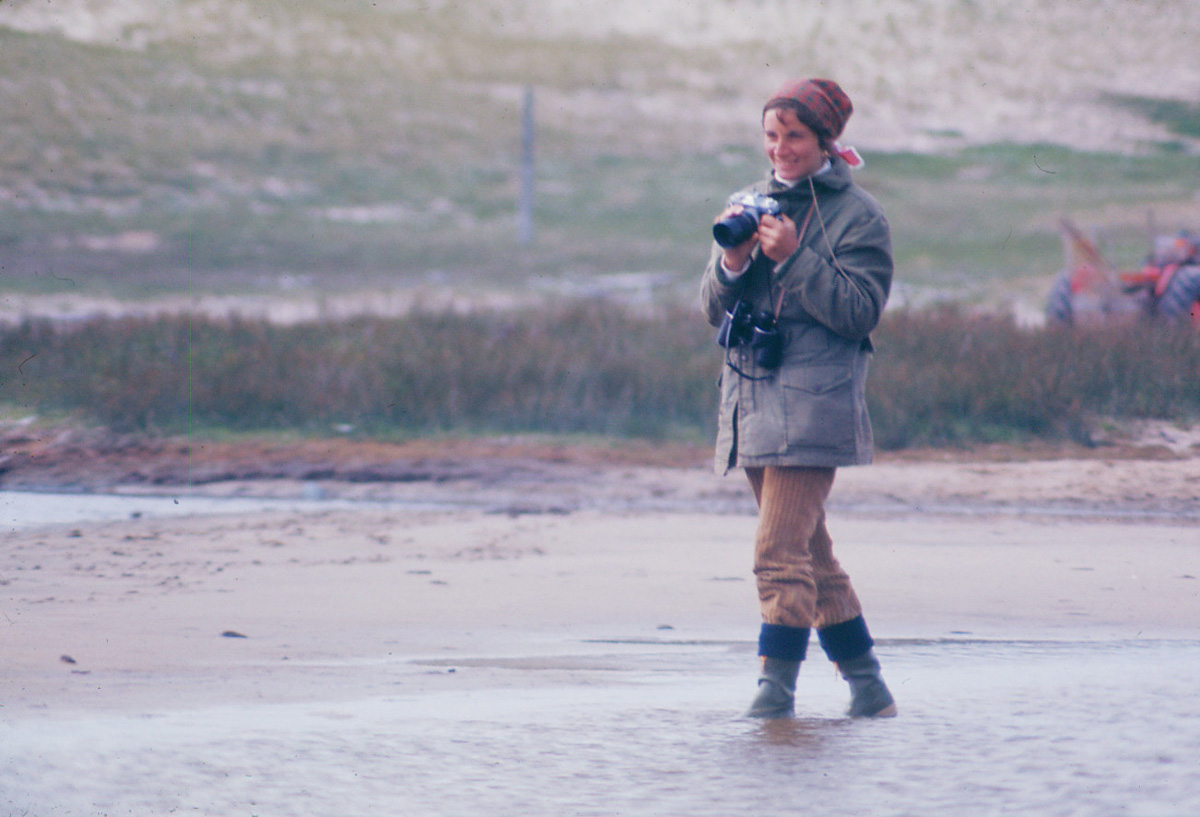
Biologist Simone Fugulin, my wife, assisted in 1973 with the sparrow counts and with my fieldwork on Harbour Seals (Photo Jean Boulva).
I established my quarters at East Light and often other researchers took a room there while on the island. Regularly, we all contributed to Ian’s major research project on the Ipswich Sparrow led by his Ph.D. student Wayne Stobo. We helped with the sparrow count by walking the island, forming a line which went from one side to the other, covering the grassy vegetated areas on the dunes.
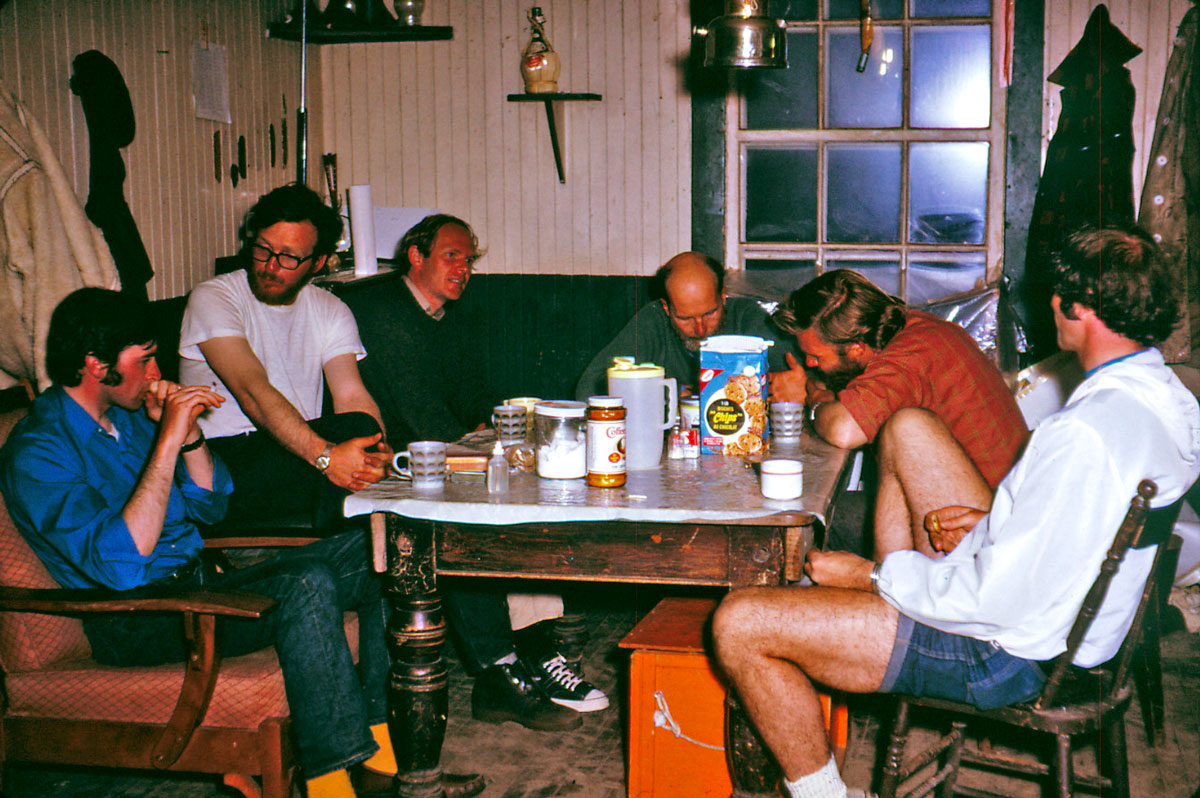
Discussions and making notes in the evening at East Light. Left to right: John Shaw, Wayne Stobo, Rodger Boyle, Ian McLaren, Dan Welsh and Doug Rankin (Photo Jean Boulva, June 13, 1971).
I had many stays at East Light with Daniel Welsh, another of Ian’s students. He was studying the horse population for his Ph.D. I certainly felt more secure sharing the fieldwork with a colleague, particularly during the often harsh winter field trips, as East Light was 20 km from the meteorological station which was staffed year-round.
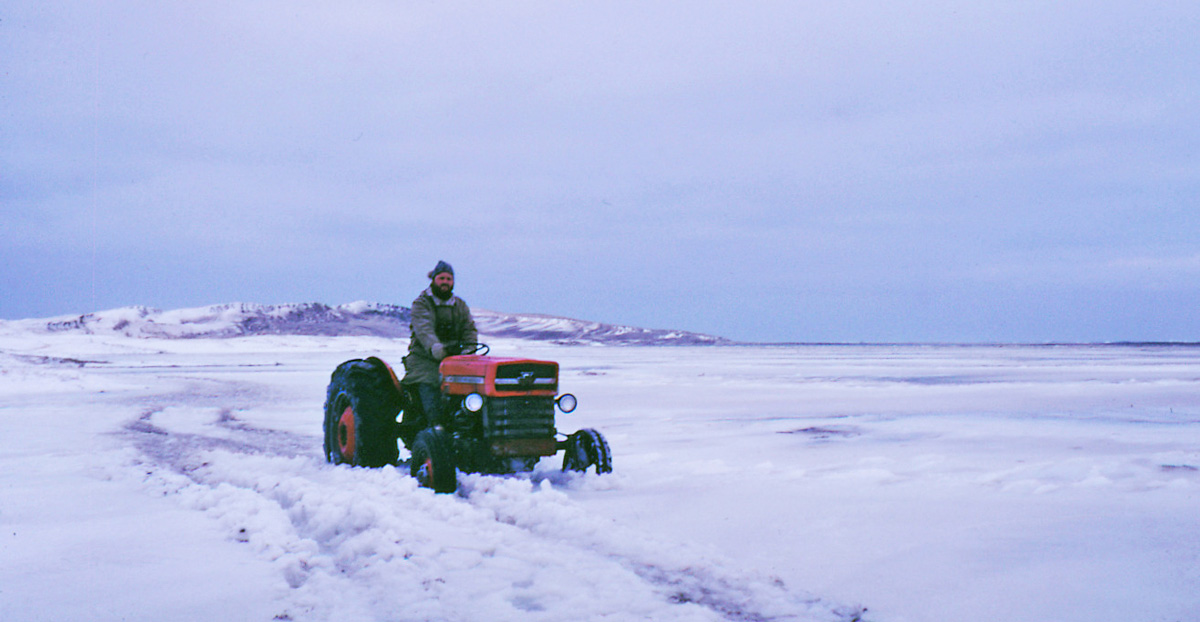
Travelling from East Light to Main Station on a flooded beach covered with slush after a winter storm. Daniel Welsh is on the second tractor (Photo Jean Boulva, February 26, 1971).
On many occasions, particularly during spring and summer, enthusiastic ornithologists came to help with the sparrow censuses. It was a rare opportunity for them to access this hard to reach nature paradise. My numerous visits there allowed me to observe 182 bird species including rarities such as the first record of a Franklin’s Gull for Nova Scotia, and, with Ian, the second record of a Wilson’s Plover. There were other unexpected sightings such as on May 16, 1970 when a Glossy Ibis and a lone Snow Bunting were observed standing side by side at the edge of a pond near old Life Saving Station No 3.
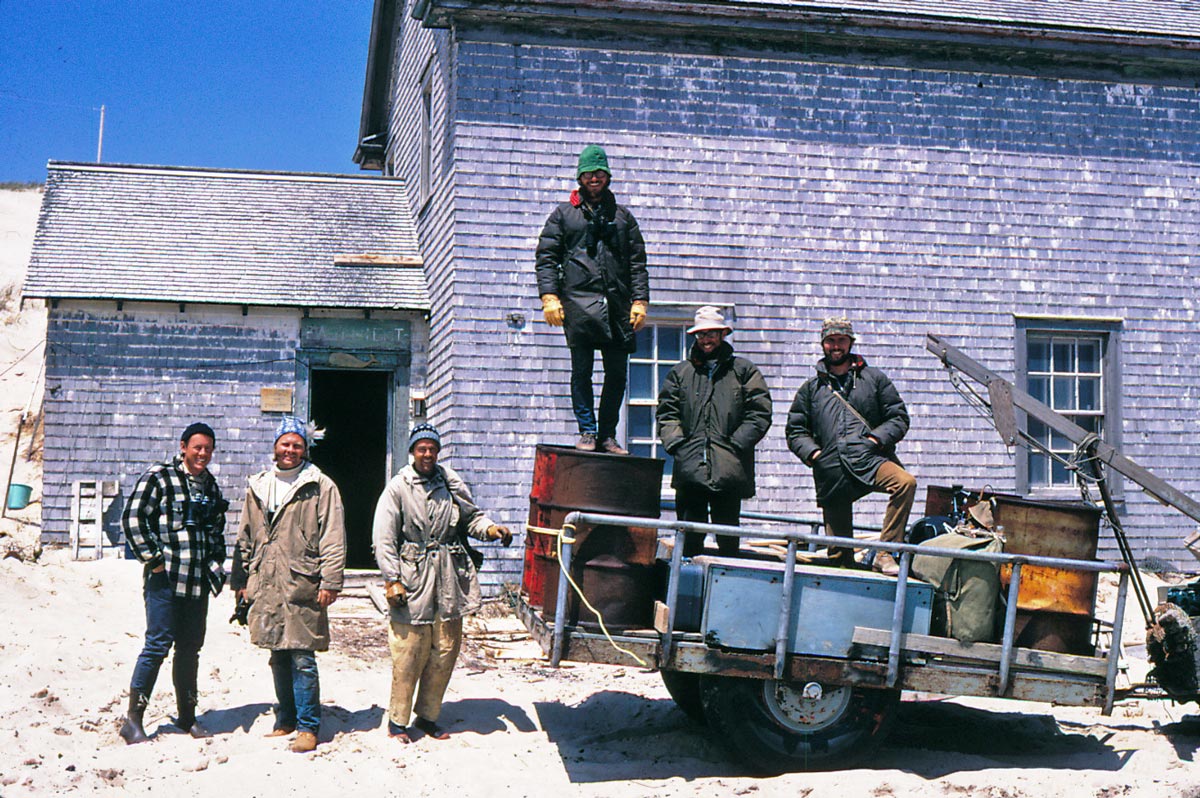
Group at East Light getting ready to start a spring Ipswich Sparrow census. Left to right: Davis Finch, Dan Welsh, Fred Bruemmer, Wayne Stobo, Eric Mills and Ken Ross (Photo Jean Boulva, May 28, 1972).
For us students as well as for our professors, it was often difficult fieldwork with long hours, but we felt so lucky to be able to spend so much time in such an unforgettable nature haven. And I can say that I enjoyed every day while on Sable. We all can be grateful to Dr. McLaren for having interested the scientific community in initiating so many research projects to better know and preserve this unique island.
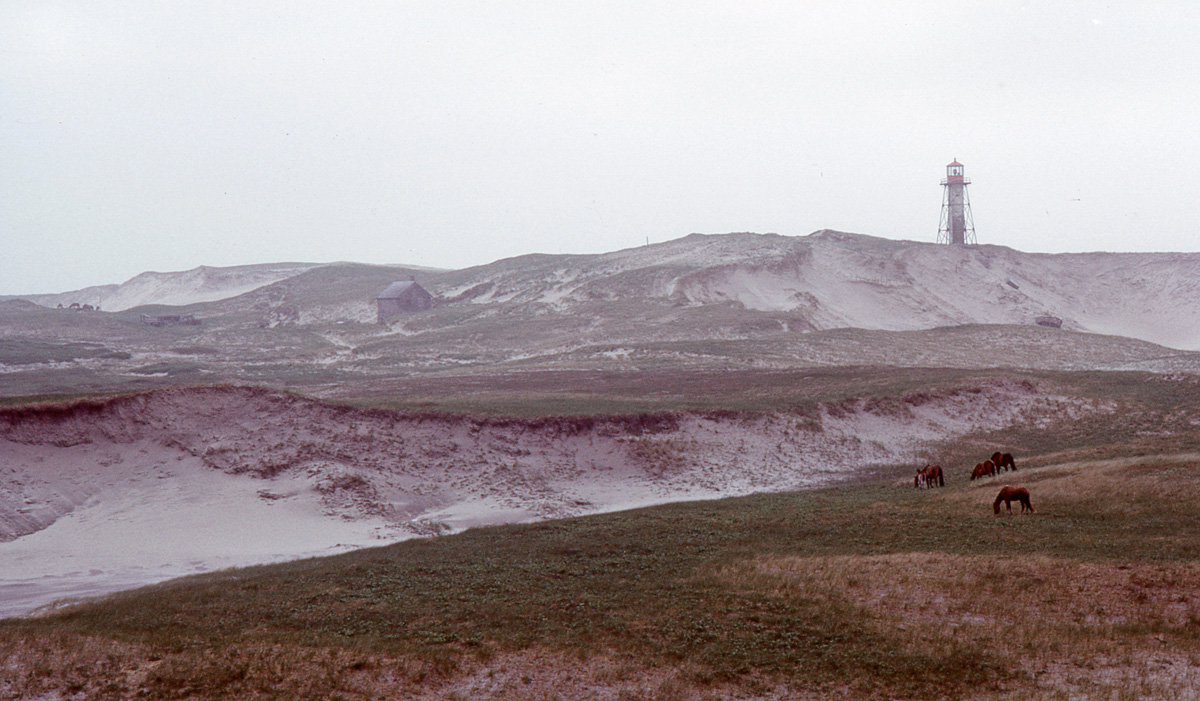
East Light area in summer, June 1973 (Photo Simone Fugulin)
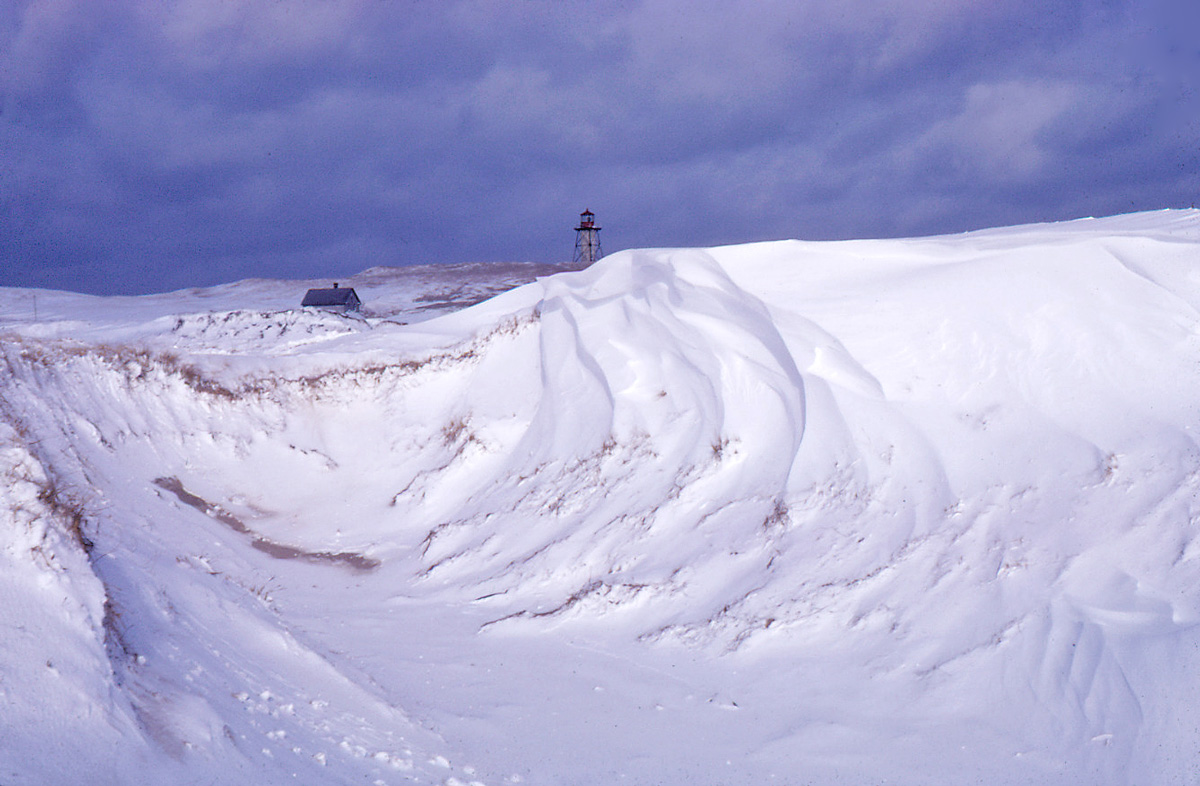
East Light area in winter, February 1971 (Photo Jean Boulva)
Jean Boulva
Prepared for the Sable Island Institute, March 2, 2024
For more about Jean’s research:
Boulva, Jean. 1971. Observations on a colony of whelping harbour seals, Phoca vitulina, on Sable Island, Nova Scotia. J Fisheries Research Board of Canada, 28: 755-759.
For more about the Ipswich Sparrow:
Ipswich Sparrow Demography Project
Just a Gray Bird (Andy Horn, 2017)
Resighting Survey for Banded Sparrows on Sable Island (Zoe Lucas, 2020)

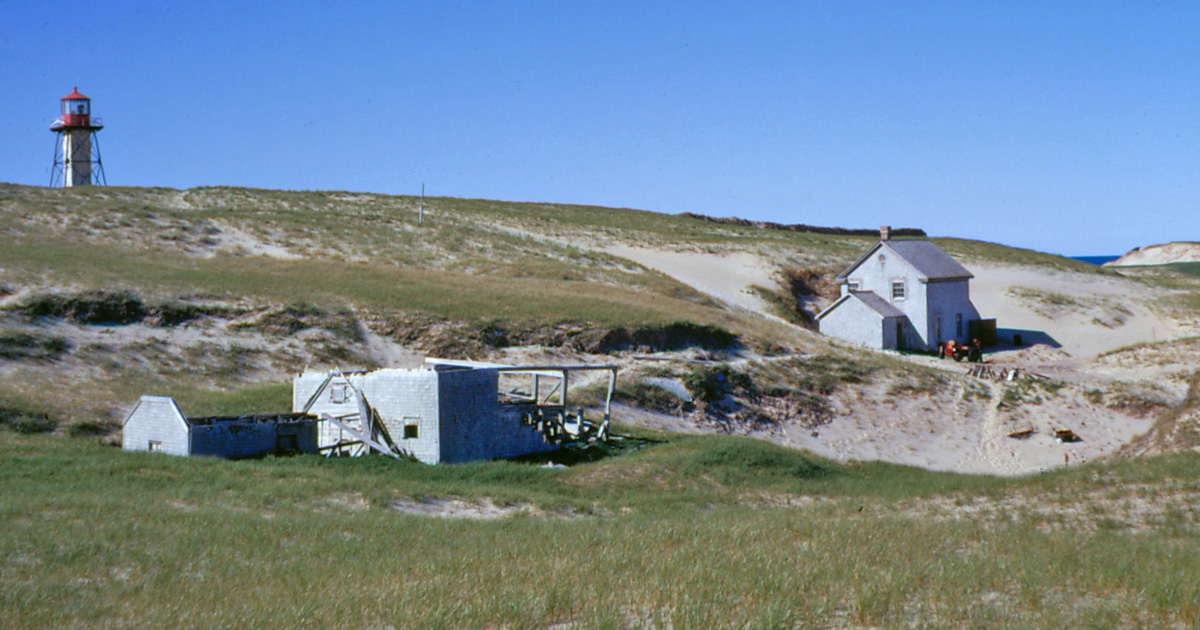
6 Responses
Brings back a lot of memories. Ian began the Ipswich project in 1967 with initial surveys and territorial and production research. I was in a Masters program at the University of Ottawa at the time, studying effects of pollution on fish growth in the Ottawa River. Ian contacted me in the fall of 1967 and offered a PhD program on the Ipswich Sparrow. I was mid-way through my Masters Research and felt I had to complete that so declined; Ian offered to hold the project for me. I moved to Halifax in February 1969 and went to Sable in April of that year to commence my PhD project. I spent summers on the Island from 1969 through 1972, and during that period, Ian had 4 graduate students working on the Island. Jean (Harbour Seals) and myself (Ipswich Sparrow) and Tony Locke (Blackback Gulls) and Danny Welsh (Horses). Ian spent time on the Island with each of us during that period, mentoring us and providing technical support. Jean and Danny, and spouses, stayed at the East Light house during those summers, Tony and I, and spouses, stayed in buildings at the West Light complex of the main Station. As I recall, in the summer of 1970, a waif of a girl with an degree in Art and Design, with little more than the clothes on her back and camera arrived (Zoe Lucas); she stayed with us in a large Quonset House at the West End of the Island that summer. And so started a career as a key Sable Island advocate, protector and researcher.
The photo that Jean included in his presentation of 6 of us in front of the East Light house in May 1972 was the first and only full island census of the size of the Sable Island Ipswich breeding population. During that two week period we (including Jean), spread ourselves in a line across the Island (north to south) and walked the full length of the Island (west to east) in a zig-zag path counting every Ipswich we saw (approx. 2400 breeding birds). Ian was also part of that group but had to leave the island partway through the census. In September of 1972, a smaller group of us re-did the census (prior to the fall migration of the sparrows) and counted in excess of 20,000 Ipswichs, reflecting the incredible productivity of the bird, with females having up to 4 nests per season and males up to 3 females in their territories.
Those years were incredible for us fortunate to having the opportunity to spend that time on such a unique Island. I have often said those trips were a time for me to recover my soul.
I was fortunate that in 1977 I had the opportunity to initiate DFO seal research projects on both grey and harbour seals, and over the next 18 years I spent, on average, over two months a year on Sable.
Thanks Wayne for all these interesting informations which nicely add to what I presented. The Sable period of our life will never go away with all the friends and events associated to these unique years on this unique land.
How wonderful to learn of your life on Sable Island and your following years of research. To have been able to return to Sable throughout your career was certainly a blessing. Mary and I remember well those years when you were studying out of Dalhousie under the supervision of Dr. McLaren and living in the flat on Inglis St. When you graduated, Mary and I moved into it and stayed for four years. That was almost 50 years ago – how time flies!
I spent one year on Sable 1958/59 (exactly 12 months) employed by federal Dept. of Transport as a Morse Code wireless operator whereby all communications with the N.S. mainland were through our Morse keys. We were also trained in meteorology to the extent that hourly weather observations were taken when on our 8 hour shifts and sent to Meteo Halifax at the top of each hour thus each shift saw us take 8 observations plus the ceiling results (in cloudy conditions) of releasing/timing hydrogen filled balloons with a reported cloud ceiling. My stay on Sable with the wild horses (an official count in 1958 using all available volunteers riding a Sable pony (spread out across the Island sandbar beginning at the West Lighthouse) , two groups- one riding and counting to the East Light and one group riding and counting westward. The total count was an astonishing 415 horses (no doubt there were some count errors but still a remarkable population of wild horses for a massively deep sand isle in the north Atlantic ocean), left to thrive on the Marram grass, seaweed and cranberries/vine after their ship was forever lost on Sable, most often during a blanket of thick fog (never seen so dense elsewhere) during my years at sea or to experience one of the many gales of hurricane force winds and flying sand that I witnessed myself).
Fascinating, fascinating stories – living history. Thank you!
Thanks for sharing this history. Great to see my dad, Eric Mills (now 88), in one of the group photos. Ian McLaren was a close family friend. In late summer 1979 I spent two weeks with my family on Sable; it remains a treasured experience/memory.